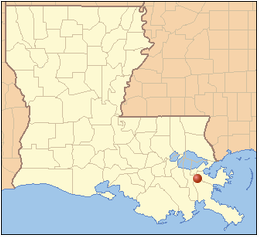| Home | Search | Emissions | Pollutants | About the Database |

Phillips 66 (2418), Belle Chasse
LDEQ Accident Report
| Accident # | 156142 |
| State Police # | 14-02219 |
| Accident Date | 2014-05-21 |
| Report Date | 2014-05-28 |
| Follow-up Date | 2014-10-20 |
| Follow-up: | No |
Pollutants Released
| Pollutant | Duration | Point Source | Greenhouse Gas | Criteria Pollutant | Ozone forming chemical | Amount of Release |
| Sulfur Dioxide | 3d 16h 6m | SRU Incinerator (591-D-21X) and Low Pressure Flare (308F-D-1) | NO | YES | NO | 89,675.0 pounds |
Accident Classified As: Reportable Quantity
Cause of Problem: Process Upset
Sulfur recovery units 591 and 592 experienced an unexpected operational upset that affected both unit flows and pressures. The sulfur conversion rates of both SRUs dropped off, subsequently overloading the tail gas treater (TGT) unit. The refinery implemented its emergency sulfur shedding procedures. The shedding of the refinery acid gas producers allowed the shutdown of SRU Unit 591. With SRU 591 shut down, the TGT unit tripped offline unexpectedly due to erratic pressure and flow swings. SRU 592 remained in operation, running at reduced rates. Its gases were routed to the SRU incinerator (591-D-21X). Higher-than-normal incinerator temperatures created safety concerns; therefore, the refinery shut down SRU 592 for a brief period of time and flared the remaining acid gas to the Low Pressure Flare (308F-D-1). Further acid gas shedding was immediately implemented with operational adjustments that included shutting down both of the refinery's diesel hydrotreaters, the delayed coker unit, while cutting the crude unit and FCC unit feed rates to minimum and charging feed stocks to both the crude and FCC units. When safe operating conditions were re-established at the SRU incinerator, Unit 592 was brought back online at reduced rates, and its tail gases remained routed to the SRU incinerator. On 5/22, it was determined that the Quench Tower (308-V-31) in the TGT train had unexpected sulfur pluggage, which had to be removed for the TGT to properly function and come back online. A repair plan resolving TGT pluggage was implemented and completed with the TGT resuming normal operations on 5/25. Continuous air monitoring was conducted at the fenceline throughout the event. Attached emissions calculations show that 750 pounds of sulfur dioxide were emitted from the SRU incinerator on 5/21, 62,500 pounds from acid gas flaring on 5/21, and 26,425 pounds from the SRU incinerator on 5/25. A Root Cause Analysis (RCA) investigation was completed and revealed there was an unexpected pluggage in the sulfur product line leading from the SRU 592 Unit to the primary sulfur storage tank. Several days prior to the incident, the primary sulfur storage tank had experienced problems with its pumping system that required several days to repair resulting in higher than normal use of the secondary sulfur storage tank to complete the loading and filling of sulfur trucks. When repairs to the pumping system were completed, the sulfur product piping of the SRU 592 Unit was rerouted from the secondary sulfur storage tank back to the primary sulfur storage tank. The initial SRU pressure increase coincided with this rerouting and the pluggage in the sulfur product piping led to the gradual buildup of molten sulfur in the condensers, reduced cross sectional area of the flow path and increased operating pressure of the SRU 592 Unit. Many operational changes (such as shifting of acid gas loads as well as sulfur shedding) were attempted to compensate for the pressure rise but were not successful. In determining all contributing causes to this incident, further investigation revealed that the slow responses to the rapid pressure and air rate changes by the air demand analyzer, the Tail Gas Treater (TGT) hydrogen analyzer, and the main air ratio controller led to out of balance air to gas ratios causing overloading of the TGT Unit, preventing it to convert sulfur dioxide in to hydrogen sulfide. This phenomenon ultimately resulted in elemental sulfur precipitation in the TGTs quench tower, leading to a total shutdown of the TGT until the quench tower could be repaired.
Discharge Preventable - No
Unexpected reduction in sulfur plant conversion rates resulting in overloading of tail gas treater unit, causing it to trip offline.
Notes/Remedial Actions
Immediate corrective action included implementation of the refinery's sulfur shedding plan reducing the sulfur load to the Sulfur Recovery Units. The sulfur shedding plan is documented in the refinery's Consent Decree required Preventative Maintenance and Operability (PMO) plan. The following corrective actions were identified after a Root Cause Analysis was conducted: 1) Develop methods to detect and identify line pluggage in sulfur product piping systems of the SRU Units 2) Conduct a refresher class with operators regarding operation of all equipment in the sulfur recovery system. Include the lessons learned from this incident as part of this review. Note that two different durations are given for this event. In the attachment, the event was said to have occurred for 88.1 hours. Earlier in the document, the figure is given as 5,870 minutes, which converts to 97.8 hours.

Connect With Us: